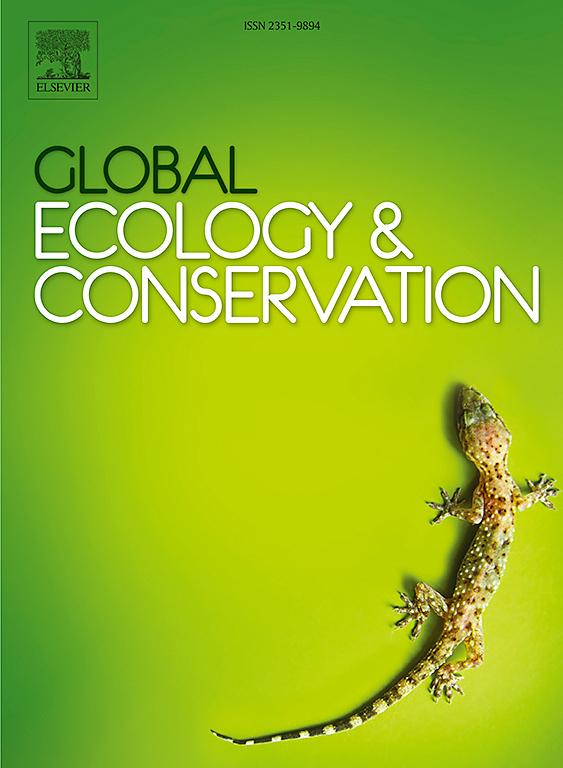Tracking data reveal high spatiotemporal consistency in migration of the threatened Taiga Bean Goose (Anser fabalis middendorffii) along the East Asian-Australasian flyway
IF 3.5
2区 环境科学与生态学
Q1 BIODIVERSITY CONSERVATION
引用次数: 0
Abstract
Migration consistency, the tendency of migratory birds to repeatedly use familiar breeding, stopover and wintering sites across years and seasons while maintaining a stable migration schedule, is advantageous as it minimizes the time and energy required to explore new environments, reduces mortality and improves overall fitness. Understanding migration consistency is essential for elucidating migration ecology, protecting migratory birds and their habitats. From 2017–2021, we tracked 24 Taiga Bean Geese breeding in the Mongolian-Russian taiga forest to analyze the duration of their four stages in annual cycle, migration parameters, spatial consistency and the temporal consistency of departure and arrival dates at summering and wintering sites. Furthermore, we evaluated the conservation status of the Taiga Bean Goose along its migration corridor. Our results revealed significant differences in the duration of the four annual cycle stages. The summering was the longest (138 ± 12 days), followed by the wintering (102 ± 13 days) and autumn migration (79 ± 13 days), while the spring migration was the shortest (47 ± 8 days). The geese exhibited high spatial consistency in migration routes and strong temporal consistency in departure from and arrival at summering sites, whereas the timing of arrival at and departure from wintering sites was more variable. Repeatedly used stopover sites across and within years were primarily located in the Hongyashan Reservoir and Hetao Plain in China, and the Orkhon River Valley in Mongolia. The stopover duration at repeatedly used sites in both seasons was significantly longer than that at sites used only in spring. Alarmingly, only 13 % of critical stopover sites currently fall within protected areas. Given the geese’s heavy reliance on the underprotected yet consistently utilized stopover sites across annual cycle, urgent conservation action is needed.
追踪数据显示,受威胁的针叶林豆鹅(aner fabalis middendorffii)沿东亚-澳大拉西亚飞行路线的迁徙具有高度的时空一致性
迁徙一致性,即候鸟在保持稳定的迁徙时间表的同时,在不同的年份和季节重复使用熟悉的繁殖地、中途停留地和越冬地的趋势,是有利的,因为它最大限度地减少了探索新环境所需的时间和精力,降低了死亡率,提高了整体适应性。了解迁徙一致性对于阐明迁徙生态学、保护候鸟及其栖息地至关重要。2017-2021年,对24只在蒙古-俄罗斯针叶林繁殖的针叶林豆雁进行了年周期四个阶段的持续时间、迁徙参数、空间一致性以及夏冬地离港日期和到达日期的时间一致性分析。此外,我们还评估了针叶林豆鹅迁徙通道沿线的保护状况。我们的研究结果揭示了四个年度周期阶段持续时间的显著差异。夏季迁徙时间最长(138 ± 12 d),其次是越冬(102 ± 13 d)和秋季迁徙(79 ± 13 d),春季迁徙时间最短(47 ± 8 d)。雁的迁徙路线具有较高的空间一致性和较强的时间一致性,而到达和离开越冬地点的时间变化较大。历年多次使用的中转站主要位于中国洪崖山水库、河套平原和蒙古鄂尔孔河流域。两个季节重复使用点的停留时间均明显长于春季使用点。令人震惊的是,目前只有13% %的关键中途停留地点位于保护区内。考虑到雁在一年的周期中对保护不足但持续使用的中途停留地的严重依赖,迫切需要采取保护行动。
本文章由计算机程序翻译,如有差异,请以英文原文为准。
求助全文
约1分钟内获得全文
求助全文
来源期刊

Global Ecology and Conservation
Agricultural and Biological Sciences-Ecology, Evolution, Behavior and Systematics
CiteScore
8.10
自引率
5.00%
发文量
346
审稿时长
83 days
期刊介绍:
Global Ecology and Conservation is a peer-reviewed, open-access journal covering all sub-disciplines of ecological and conservation science: from theory to practice, from molecules to ecosystems, from regional to global. The fields covered include: organismal, population, community, and ecosystem ecology; physiological, evolutionary, and behavioral ecology; and conservation science.
 求助内容:
求助内容: 应助结果提醒方式:
应助结果提醒方式:


